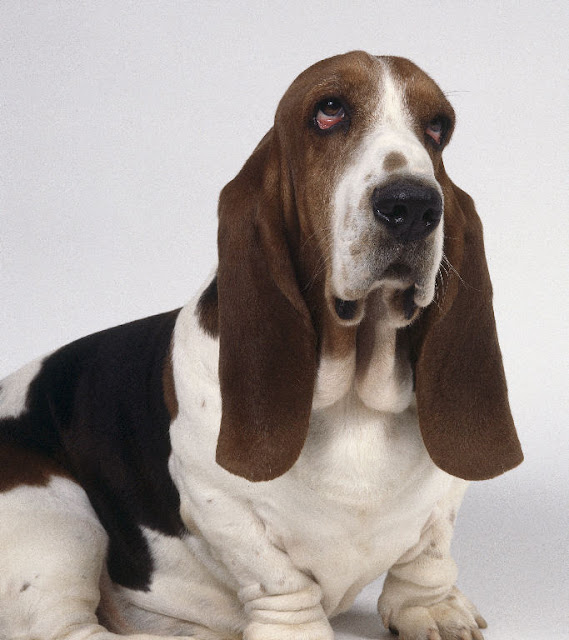The Beagle is also known as: English Beagle
Fast Facts
| Group classification: Hound | Country of origin: England | Date of origin: 14th century |
| Weight (M): 22 - 30 lb | Height (M): 13" or 15" | Life expectancy: 13 - 15 years |
| Weight (F): 18 - 25 lb | Height (F): 13" or 15" |
#
General Description of the Beagle
The Beagle is a small hound bred for hunting rabbit and hare. The head is somewhat lengthy and is domed at the occiput. Eyes are hazel or deep brown in color, large and set apart with a soft, "pleading" expression that is common to most hounds. The finely textured ears are long, low set and gently rounded at the tips. The medium-length muzzle is square and straight with a somewhat defined stop. The shoulders and chest are broad and muscular, without being bulky. The well-muscled back is short and the loin is wide and gently arched. The gaily carried tail is high-set with a light curve, and is rather short when compared to the Beagle's size. Coloring can be any true hound color. The length of the coat is medium/close and the texture is coarse.
Beagle Temperament
The Beagle is extremely friendly and gentle—traits that make fit very well in a family environment. Beagles are perfect for families with children, as they are tolerant, loving and playful. They can be kept in homes with other animals but must be socialized early because of their hunting instincts. The Beagle can live indoors but requires a fenced yard in which to roam in addition to a daily walk. The Beagle does not like to be left alone, so owners would be well advised to keep a companion animal with their Beagle, especially when away. It is important that a Beagle is walked on a leash in order to prevent it from running off in pursuit of intriguing scents. This breed responds well to obedience training if worked with regularly. Potential owners should also keep in mind that the Beagle was bred to have a strong, melodious bark/howl for hunting purposes—a characteristic that may potentially disturb neighbors.
#
Caring for a Beagle
Because the Beagle has shorter hair, it's easy to groom. Simply brush regularly with a firm bristled brush and bathe with mild dog shampoo when needed. The ears do require a bit of maintenance and should be kept clean. If the ears become infected or show signs of ear mites, your vet can provide you with special treatment options. Also, make sure to keep the nails trimmed. The Beagle requires daily exercise in the form of either a free roam in an enclose area or a long walk. Major health concerns for the Beagle are intervertebral disk disease and canine hip dysplasia; minor concerns include glaucoma, epilepsy, CPRA, hypothyroidism, patellar luxation, chondrodysplasia, distichiasis and KCS.
Origin of name Beagle was taken from an ancient French word that berate the open throat in reference to the breed's melodious bay (open throat that shows that dogs are barking like a melodious voice) or perhaps also of Celtic, old English or French ancient small berate. Beagle word is not used up in 1475 but later found his writing again in the 16th century.
In the late 19th century popular Beagle is regarded as a competitor in various exhibitions. Beagle later became one of the favorite breed of dog in America all the time. Beagle is actually intended to hunt and he can do well. Powered by olfactory as well as hound, Beagle tend to follow what is indicated by the smell and ignore everything else. This leads to obedience training early in life is a must. Origin Beagle is a cross between Herrier with other types of England Hound.
Beagle is a dog that looks like a Miniature Foxhound. The size is medium. Beagle coarse fur, berdekatang so they can protect him from the bush. Beagle very friendly dog ​​that gets along well with humans or other dogs when joining the group of hunters.
Beagles including descent groups (breed group) Hound (police), with the high reaching 13 inches and in color from the color tricolor hound dog really is. This kind of dog has long hair with a medium, so the maintenance is relatively easy.
Beagle hound type dogs including the most friendly. Beagle is a hunting dog who needs to establish friendly relations with both people and other dogs. These dogs like to roam outdoors. Beagle is an independent dog, gentle and wonderful. Baegle dog is a dog who is very energetic and active. Beagle is very vigilant to not show shyness or signs of attack. Beagle can be very mischievous and bold, so precaution is needed when exercise and socialize as well.
Beagle dog is a very nice dog in the family, because they are a cheerful dog and can adapt. But Beagle dog likes to bark and howl.
Grooming Beagle dog is very easy because the body does not have body odor. Beagles is usually enough bathed once a week or when visibly soiled wipe enough alone. The main concern at the ears, because the ear is closed making it easy to dirty and ear infection.
The typical lifetime of Beagles are 10-13 years old, which is a joint life expectancy for dogs their size. Beagles can be prone to epilepsy, but this can be controlled with medication. Hypothyroidism and a number of types of dwarfism occur in Beagles. Two conditions are particularly suitable for the breed: Funny Puppy, in which the puppy develops slowly and eventually develop weakness in the legs, arched back and although normally healthy, is prone to a variety of diseases, joint dysplasia the Harrier and some large breeds hip is rarely considered a problem in Beagles. Beagles are considered a race chondrodystrophy, which means they are subject to the types of disc disease.
Weight gain can be a problem in older or sedentary dogs, which in turn can lead to heart problems and joint. In rare cases Beagles may develop immune mediated polygenic arthritis (where the immune system attacks the joints) at an early age. The symptoms can sometimes relieve the steroid treatments.
His long ears may mean that the inner ear receives a large flow of air or moist air is trapped, and this can lead to ear infections. Beagles may also be affected by a number of eye problems, two common eye conditions in Beagles are glaucoma and corneal dystrophy [49] "Eye Cherry", a prolapsed gland of the third eyelid, and distichiasis, a condition in which eyelashes. grow in the eye, causing irritation, sometimes exist, these two conditions can be corrected with surgery. They may suffer from various types of atrophy of the retina. Lack of tear drainage system can cause dry eye or leakage with tears on his face.
Like dogs on the ground they are prone to minor injuries such as cuts and sprains, and, if inactive, obesity is a common problem because they eat when food is available and rely on their owners to regulate weight. When working or running free, they are also likely to pick up parasites such as fleas, ticks, chiggers and tapeworms, and irritants such as grass seeds can be trapped in their eyes, ears soft or legs. Beagles can occur in the behavior is called reverse sneezing, in which sound as if they are choking or gasping, but actually drawing air through the mouth and nose. The exact cause of this behavior is not known, but it does not hurt the dog.




























































